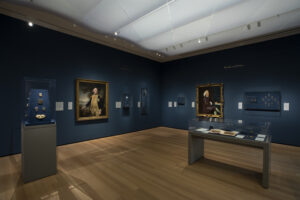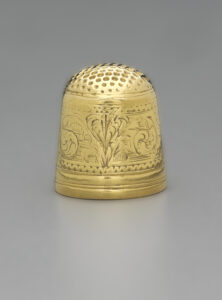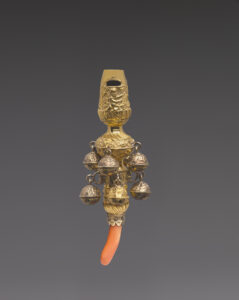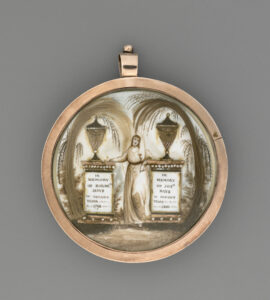Episode 159
What you’ll learn in this episode:
- Why we often have more information about gold than any other decorative object
- The difference between material culture and material studies, and how these fields shaped the study of art and jewelry
- What John wants visitors to take away from “Gold in America: Artistry, Memory and Power”
- Why history is much more global than we may think
- What it really means to curate, and why it’s an essential job
About John Stuart Gordon
John Stuart Gordon is the Benjamin Attmore Hewitt Curator of American Decorative Arts at the Yale University Art Gallery. He grew up among the redwoods of Northern California before venturing East and receiving a B.A. from Vassar College, an M.A. from the Bard Graduate Center for Studies in the Decorative Arts, Design, and Culture, and a PH.D. from Boston University. He works on all aspects of American design and has written on glass, American modernism, studio ceramics, and postmodernism. His exhibition projects have explored postwar American architecture, turned wood, and industrial design. In addition, he supervises the Furniture Study, the Gallery’s expansive study collection of American furniture and wooden objects.
Additional Resources:
- Yale University Art Gallery Website
- Yale University Art Gallery Instagram
- John Stuart Gordon Instagram
Photos:
[installation view] “Gold in America: Artistry, Memory, Power” is the first survey of American gold since 1963. It includes jewelry, housewares, presentation gifts, as well as coins, paintings, and photographs that illuminate the continued allure of gold over the centuries.

[thimble] Curator John Stuart Gordon hopes visitors will come away with a renewed curiosity for the gold they encounter in their lives. An object like this thimble–a rare survival made in Boston in the 1730s–are easy to overlook, but it documents the story of a young widow who became a successful merchant and was able to pass a gold thimble on to her daughters. Jacob Hurd, Thimble for Elizabeth Gooch Hubbart Franklin, Boston, 1730-40. Gold. Yale University Art Gallery, Mabel Brady Garvan Collection

Objects open up whole worlds when interpreted through the lens of material culture. Many children wore rattles or teething sticks around their necks, but few were made of gold and coral like this example. Made in New York in the 1760s its swirls, scrolls, and flowers are typical of the Rococo style. Its function speaks to social beliefs surrounding childhood, such as the use of coral that was believed to protect children. It was a gift from a grandmother to her granddaughter, a gift of love but also a way of passing wealth between women in the family. Daniel Christian Fueter, Whistle and Bells for Mary Duane North, New York, 1761–65. Gold and coral. Yale University Art Gallery, Mabel Brady Garvan Collection, Gift of Mrs. Francis P. Garvan, James R. Graham, Walter M. Jeffords, and Mrs. Paul Moore

Gold’s value and resistance to corrosion have made it a metaphor for the lasting nature of love and memory. This heart-breaking pendant uses gold, watercolor on ivory, and human hair to commemorate the deaths of two infant brothers. The weeping willows over the graves are made from locks of each boy’s hair while the figure in the center may be their mother. The economic value of gold is often rivaled by its sentimental value. Memorial for Solomon and Joseph Hays, probably New York, 1801. Watercolor, pearls, gold wire, beads, and hair (natural, chopped, and dissolved) on ivory. Yale University Art Gallery, Promised bequest of Davida Tenenbaum Deutsch and Alvin Deutsch in honor of Kathleen Luhrs

Transcript:
Perhaps more than any other metal or gem, gold brings out strong reactions in people (and has for all of recorded history). That’s what curator John Stuart Gordon wanted to explore with “Gold in America: Artistry, Memory, Power,” a featured exhibition now on view at the Yale University Art Gallery. He joined the Jewelry Journey Podcast to talk about why people have always been enchanted by gold; what he discovered while creating the exhibit; and why curation is more that just selecting a group of objects. Read the episode transcript here.
Sharon: Hello, everyone. Welcome to the Jewelry Journey Podcast. This is the second part of a two-part episode. Today, my guest is John Stuart Gordon, the Benjamin Attmore Hewitt Curator of American Decorative Arts at the Yale University Art Gallery. Welcome back.
I’m curious; I know you recently had a group from Christie’s studying jewelry that came to visit your exhibit. I’m curious if they asked different questions, or if there’s something that stood out in what they were asking that might have been different from a group studying something else.
John: Every group is different. I love them all, and I learn so much from taking groups of visitors through because you start looking at objects through their lens. Recently a group of makers came through and, wow, that was a wonderful experience, because I could make a reference to, “Oh, look at the decoration on this,” and then, “Is it chaste or is it gadroon?” “What kind of anvil are they working with?” We have to answer these questions. There are some things I can’t answer but a maker can identify easily, so I’m learning things.
Maybe someone who’s a collector or an appraiser is thinking about objects in a very different way, wanting to know how rare it is, if there are only a handful, where they are, how many are still in private collections, what’s in the museum collection. One of my favorite tours was with a small group of young children who had a completely different set of preconceived notions. I had to explain what an 18th century whistle and bells would have been used for because they’d never seen one before. I had to talk about what kinds of child’s toys they remembered from when they were kids, trying to relate. Every group has a slightly different lens, and you can never anticipate the questions they’re going to ask.
Sharon: Yes, they’re coming at you from the weirdest angles. In putting this together, what surprised you most about gold in America? What surprised you most about putting this exhibit together? What made you say, “Gosh, I never knew that,” or “I never thought about that”? There’s a lot, but what’s the overriding question, let’s say.
John: It’s such a nerdy answer, and I apologize for being such a nerd, but what surprised me the most was an archival discovery. Mind you, this all takes place against the background of lockdown and having way too much time on our hands and looking for distractions. I pulled a historical newspaper database that the library subscribes to, and I typed in the word “gold” and pushed enter. There were about three million responses that came back, and I just started reading my way through. Not all of them were interesting, but I was struck by the frequency with which people were discussing gold, and I was struck by the global knowledge at a very early period. I would find articles written in the 1720s in colonial Boston talking about the Spanish fleets leaving Havana Harbor with amounts of silver and gold onboard. They would describe how much gold, how much silver, was it coins, was it bars, was it unrefined. There was a newspaper report coming out of New York in the 1750s talking about a new gold strike at a mine in Central Europe. That was truly unexpected: to realize that this material was of such importance that people were talking about it on a daily basis, and that it was newsworthy on this global scale. People weren’t just talking about what was going on in colonial Boston or colonial Philadelphia. They were talking about what was going on in Prussia and Bogota. I think we often think of early history as very insular, and we think of our present day as global. History has always been global, and it was a lovely reminder of how global our culture always has been.
Sharon: That’s interesting, especially talking about global. I just reread Hamilton. They’re talking about Jefferson and Madison and everybody going over to France and coming back. I think about the boats, and I think, “Oh, my god.” I think of everybody as staying in place. You couldn’t get me on one of those boats. What a voyage. But that was global. Everybody was communicating with everybody else. So, yes, it always has been that way, but it’s very surprising, the movement that has been there for so long. We could go on and on about that.
Let me ask you this: Yale Art Gallery just received a donation from Susan Grant Lewin of modern jewelry, art jewelry, on the cutting edge. At the museum and gallery, is the emphasis more on jewelry as part of material culture and decorative arts? Not every museum or art gallery would have been open to it. What’s the philosophy there?
John: Yes, we just received a gift of about two dozen pieces of contemporary jewelry from Susan Grant Lewin, who is a collector and scholar. We’ve also received a gift from the Enamel Arts Foundation, which is a foundation that collects and promotes enamel objects and jewelry. We have a long history of collecting jewelry, and it’s based on historic collections. The core of the American decorative arts collection is the Mabel Brady Garvan Collection. It started coming to the art gallery in 1930. It’s this rather storied collection. It covers everything you can imagine: furniture, glass, ceramics, textiles, you name it.
It was assembled by a man named Francis P. Garvan, who was a Yalee. He graduated in the late 19th century and he gave it in honor of his wife. His main love, after his wife and his family, was silver, and the collection at Yale is probably the most important collection of early American silver in any museum. Silversmiths and goldsmiths, the names are interchangeable, and it is mostly men at that period who were making silver objects and gold objects. They’re also making jewelry. As you take the story forward, it doesn’t change a lot. People who are trained as metalsmiths often will make holloware and/or jewelry. The fields are very closely allied, and the techniques are very closely allied. So for us, it makes complete sense to have this very important historical collection of metalwork go all the way up to the present.
We have a lot of 20th century jewelry, now 21st century jewelry. We also have contemporary holloware because we like being able to tell a story in a very long arc. The way someone like Paul Revere is thinking about making an object and thinking about marketing himself is related to how someone graduating from SUNY New Paltz or RISD are thinking about how to make an object and how to market themselves. Often it’s the same material, the same hammers, the same anvils. So, it’s nice to show those continuities and then to bring in how every generation treats this material slightly differently. They have their own ideas and their own technologies.
So, the Susan Grant Lewis Collection is a very experimental work. She has said she doesn’t like stones, so you’re not going to see a lot of gem setting and a lot of diamonds and rubies set in gold. There’s nothing wrong with them, but she’s more interested in people who are more out there, thinking about how you turn 3D printing into art or how you use found materials and construct narratives and make things that are more unexpected.
Sharon: I just want to interrupt you a minute. SUNY New Paltz is the New York State University at New Paltz?
John: State University of New York at New Paltz. Sorry, I gave you the shorthand.
Sharon: I know RISD is the Rhode Island Institute—
John: We’re going to have to submit an index on how to understand all my acronyms. Yes, RISD is the Rhode Island School of Design. There are a handful of institutions that have really strong jewelry departments and really strong metalworking departments, among them Rhode Island School of Design, State University of New York at New Paltz. You can add Cranbrook, which is outside of Detroit. There’s a whole group of them that are producing wonderful things.
Sharon: So, you studied decorative arts. What was your master’s in?
John: I was an art historian. I was very lucky in college to have a professor who believed in material culture, and I asked, “Do I have to write about paintings?” and she said, “No, you don’t.” I was very lucky to find that in college. Then I went to the Bard Graduate Center in New York. It was a much longer title, the Graduate Center for Material Culture and Design. It changes its name every two years. My master’s was in kind of a history of design and material culture. Then to get a Ph.D., there are very few programs that allow people to focus on material culture. Luckily, there are more with every passing year. When I was going to school, Yale is one that’s always focused on decorative arts and material culture. Boston University, their American studies program is a historically strong program that allows you to look at anything in the world as long as you can justify it. So, that’s where I went.
Sharon: Was jewelry like, “Oh yeah, and there’s jewelry also,” or was jewelry part of the story, part of the material culture, the material objects that you might look at? Was it part of any of this?
John: It was. I am at core a metals person. My master’s thesis was written on the 1939 New York World’s Fair, looking at one pavilion where Tiffany, Cartier and a few others had their big exhibition of silver, gold and, of course, jewelry. My entry into it was silver, but I had to learn all the jewelry as well. So, jewelry has always been part of my intellectual DNA, but it didn’t really flourish until I got to Yale, and that would be because of my colleague, Patricia Kane. She has a deep knowledge and interest in jewelry. We have done a few jewelry exhibitions in the past, and she has seen it as part of the collection that should grow. I arrived at Yale as a scrappy, young curator seeing what was going on in the landscape, and the jewelry is amazing. One of my first conferences I went to was a craft conference. I met jewelers and metalsmiths, and it’s a really approachable group. They’re very friendly. They like talking about their ideas. They like talking about their work, which is really rewarding.
Sharon: What were your ideas when you started as a curator? Did you have the idea, “Oh, I’d love to do exhibition work”? Curate has become such a word today. Everybody is curating something.
John: Yes, my head is in my hands right now. One of my pet peeves is that people talk about curating their lunches. The word curate actually means to care for, so I think about the religious role of a curate. It’s the same role. Our job is really to care for collections. If you care for your lunch, you can curate it, but if you’re just selecting it, please use a different word.
That idea of caring for objects, that’s what really excited me as a curator; the idea that so much of what we do is getting to know a collection, to research it, to make sure it’s being treated well, that things are stable when they go on loan, that when things need treatment, you work with a conservator or a scientist. I was really excited by that.
Over the course of my career, I’ve become much broader in my thinking. When you come out of graduate school, you’ve spent years focusing down deeper and deeper on one small, little subject. I was still very focused on a very narrow subject when I became a curator. That was early 20th century design. I love it dearly, but over the years my blinders have come off. I love American modernism. I also love 17th century metalwork. I love 21st century glass. You realize you love everything in the world around you.
Sharon: Would you say your definition of curate is still to care for? I’m thinking about when I polish my silver. I guess it’s part of curating in a sense, taking care of things.
John: Polishing your silver or your jewelry is actually one of the best ways to get to know it. We’re one of the few collections where it’s the curators who polish the silver. We hold onto that task because we don’t do it very often, because it’s better to leave things unpolished if you don’t have to. But when it comes time to polish something, the opportunity to pick something up, to turn it over, to feel the weight of it, to look closely at the marks and the details, that’s a really special thing, to get to know your objects so well by doing it. I give a hearty endorsement of silver polishing. It’s also a great emotional therapy if you’ve had a tough day. But to your question, I even more strongly believe that the role of a curator is someone to care for their collections.
Sharon: I really like that. It gives me a different perspective.
John: Yeah, because what we’re doing is not just physical care; it’s emotional care. In today’s culture we talk so much about self-care and these kinds of tropes, but that’s a lot of what we’re doing. We’re understanding history through our objects. We’re understanding the objects better to have something preserved for posterity, so it can tell future generations stories.
Sharon: That’s interesting. John, thank you so much. By the way, the exhibit ends in July, but the Susan Grant Lewin Collection is open through September. You’ll be busy, it sounds like.
John: “Gold in America: Artistry, Memory, Power” closes July 10. The Susan Grant Lewin Collection of American Jewelry will be up through the fall. If you miss both of those or you’re in a place where you can’t get to New Haven, our collections are all online. All you have to do is go to our website, and you can just click through and spend a day looking at objects from the comfort of your living room.
Sharon: Yes, and very nice photos. As I said, I was looking at them before we started. I was very interested. What was that used for? Where did it come from? I guess being in Los Angeles, I’ll have to do that. I’ll be doing that from my living room. John, thank you so much. This is very, very interesting. I learned a lot and you have given me a lot to think about, so thank you so much.
John: Thank you for having me.
Thank you again for listening. Please leave us a rating and review so we can help others start their own jewelry journey.

